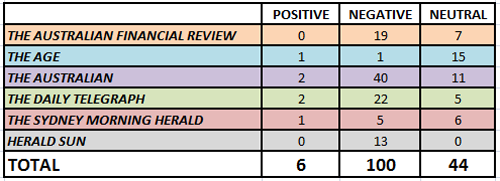
The country’s major newspapers have responded to the federal government’s proposed media reforms with a deluge of negative articles and opinion pieces, unbalanced by alternative views, a Crikey analysis has found.
Crikey has analysed six newspapers every day since the reforms were announced last Tuesday and counted 100 stories which were negative about the reforms, compared with six that were positive. Another 44 were neutral.
The newspapers surveyed were The Australian, The Daily Telegraph, the Herald Sun, The Age, The Sydney Morning Herald and The Australian Financial Review (and their weekend sisters). Crikey analysed both news articles and op-eds. The result? Media experts or Labor-aligned figures who were positive about the reforms were hard to find in the papers.
The newspapers have been writing up a storm about the proposed changes, under which the government would appoint an advocate to determine whether the media’s self-regulatory bodies were adequately policing press standards and rule on media mergers. Newspaper chiefs have portrayed this as an assault on the freedom of the press, with Communications Minister Stephen Conroy photoshopped as Joseph Stalin in The Daily Telegraph.
Articles and opinion pieces on media reform for the period March 13-18
The Australian was a stand-out, with 40 negative stories and two positive ones. Eleven were neutral. There were slightly more articles than op-eds in the mix. The slant continues today, with six negative stories.
The News Limited tabloids also delivered strongly negative coverage. The Herald Sun has run 11 pieces, all of them negative. The Daily Telegraph, while running the most extreme negative coverage, was more diverse (and prolific) than its Melbourne sister paper. The Tele ran 22 negative stories, 14 neutral and two positive stories.
Fairfax newspapers ran fewer stories about the reforms, and a higher percentage of them were neutral. The Age’s net result was neutral — there were the same number of positive as negative articles. By contrast, The Sydney Morning Herald ran net negative coverage.
*Additional research by Crikey interns Carrington Clarke and Tim Fitzpatrick









As this article shows, oh for the fair and balanced Murdoch media, just not there is it?. Just like Fux News. Even if they gave away free Lupert photographs with every paper sold, I still would not buy any of their cr*ppy products. Sky business news m*rons have been in overdrive all day on the issue.
The Murdoch tabloids in particular are campaigning for regime change to a government that will provide them with a more friendly commercial and regulatory environment. In the case of News Limited that is the winding back or ideally the destruction of the NBN and the ABC and the removal of any other obstacles to their takeover of as much of Australia’s news, communications and entertainment business that they can get their hands on. The dying newspapers are being used to provide free advertising and campaigning for their preferred side of politics.
Conroy’s changes are a joke. They are a bad idea. They are being rushed through. Even Crikey is against them.
Why all this angst about balance? When something is such a bad idea in the first place, why is there surprise when everyone criticises it?
David – the way I see it, it’s not so much about balance as it is a need for the negative side of the discussion to offer something a little more substantive and intelligent than, say, “they are a bad idea”.
How the hell do you think making papers tell the truth is a bad idea David? The problem with the Murdoch hacks here is they forget they are working for a criminal organisation and the very day Williams had his bid spray another 600 hacking victims were named to the met.